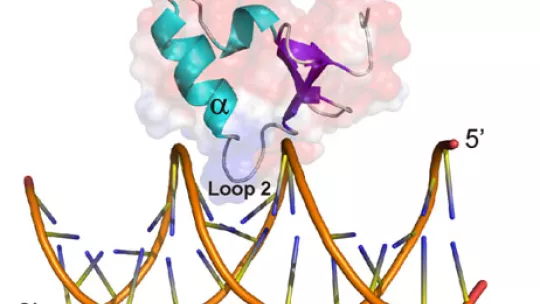Images
• Ler binds multiple DNA sequences, thereby activating numerous genes responsible for bacterial virulence.
• The findings of the study have been published in PloS Pathogens.
A team headed by scientists from the Institute for Research in Biomedicine (IRB Barcelona) reports how the protein Ler, which is found in pathogenic bacteria, interacts with certain DNA sequences, thereby activating numerous genes responsible for virulence, which bacteria then exploit to infect human cells. Ler is present in pathogenic Escherichia coli (E.coli) strains, such as the one that caused a deadly infectious outbreak in Germany last May. The study has been published in the scientific journal PloS Pathogens.
The researchers have solved the three-dimensional structure of a key region of the DNA-protein complex. Knowledge about the structures that control the activity of genes associated with virulence and resistance to antibiotics is crucial to understand the molecular mechanisms that regulate bacterial pathogenicity and to pave the way for alternative treatments to conventional antibiotics. According to Jesús García, research associate in the IRB Barcelona group headed by Miquel Pons, researcher at IRB Barcelona and professor of the UB, “a strategy based on selective regulatory systems for genes responsible for virulence is particularly attractive because it could potentially minimize the adverse effects on our bacterial flora and reduce the selective pressure for the development of antibiotic resistance in bacteria”.
Horizontal gene transfer
Many of the genes responsible for pathogenic bacteria virulence and resistance to antibiotics have been acquired through processes such as horizontal gene transfer (HGT). By means of this mechanism, bacteria incorporate genetic material from external sources such as bacteria or phages (viruses that affect bacteria). The correct regulation of HGT genes, in other words silencing when not required and coordinated activation to produce a beneficial effect, is crucial for the success of bacteria.
“The resolved structure has allowed us to understand the way in which Ler recognizes its DNA binding sites. Ler does not recognize specific sequences but local DNA structures. In our study we also tested whether this recognition mode is used by other proteins of the same family, such as H-NS”, explains García. The Ler and H-NS proteins play a critical role in the regulation of genes acquired through HGT in pathogenic E. coli strains.
The study forms part of Tiago N. Cordeiro’s doctoral thesis and has involved researchers from the Institute for Bioengineering of Catalonia (IBEC), the University of Barcelona (UB) and the Max Planck Institute for Biophysical Chemistry in Göttingen.
Reference article:
Indirect DNA Readout by an H-NS Related Protein: Structure of the DNA Complex of the C-Terminal Domain of Ler.
Tiago N. Cordeiro; Holger Schmidt; Cristina Madrid; Antonio Juárez; Pau Bernadó; Christian Griesinger; Jesus García; Miquel Pons.
PLoS Pathog 7(11): e1002380. doi:10.1371/journal.ppat.1002380
About IRB Barcelona
The Institute for Research in Biomedicine (IRB Barcelona) pursues a society free of disease. To this end, it conducts multidisciplinary research of excellence to cure cancer and other diseases linked to ageing. It establishes technology transfer agreements with the pharmaceutical industry and major hospitals to bring research results closer to society, and organises a range of science outreach activities to engage the public in an open dialogue. IRB Barcelona is an international centre that hosts 400 researchers and more than 30 nationalities. Recognised as a Severo Ochoa Centre of Excellence since 2011, IRB Barcelona is a CERCA centre and member of the Barcelona Institute of Science and Technology (BIST).






